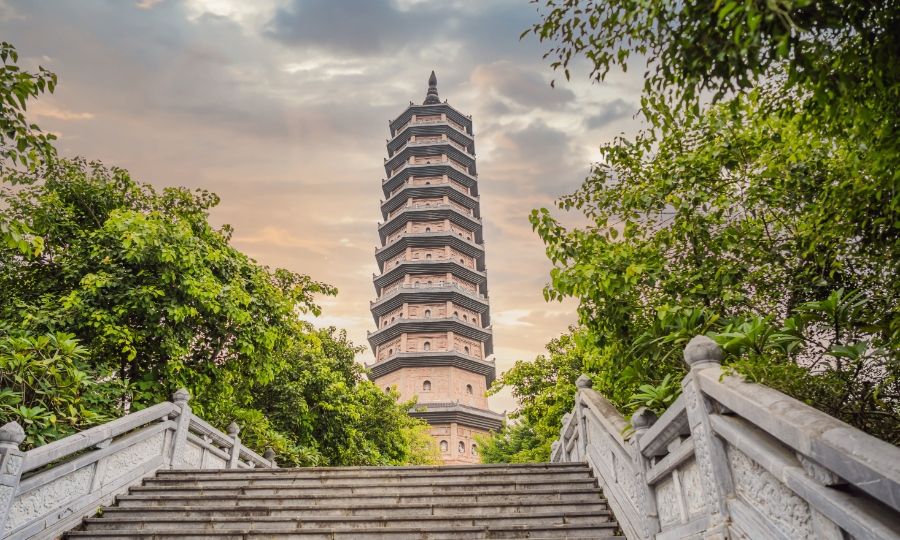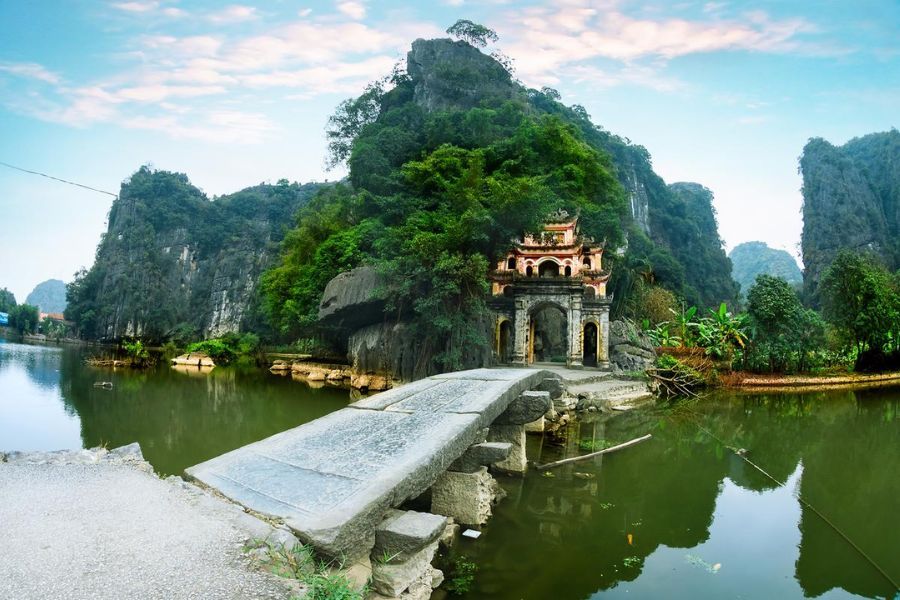Best Time To Visit Ninh Binh For Calm Weather And Golden Landscapes
Ninh Binh changes with the seasons. Some months bring cool weather and golden rice fields, while others feel dull or overcrowded. Knowing the best time to visit Ninh Binh will help you enjoy the best of it.
Table of Contents
ToggleWhere Is Ninh Binh?
Ninh Binh is a relatively small province in northern Vietnam located about 100 kilometers south of Hanoi. It is easily a day trip, but many tourists decide to stay longer because they feel like they could be in the changeless countryside in a dramatic landscape forever. But for travelers, Ninh Binh is known for its limestone mountains, rivers, and endless rice paddies; thus, the name “Halong Bay on land.”
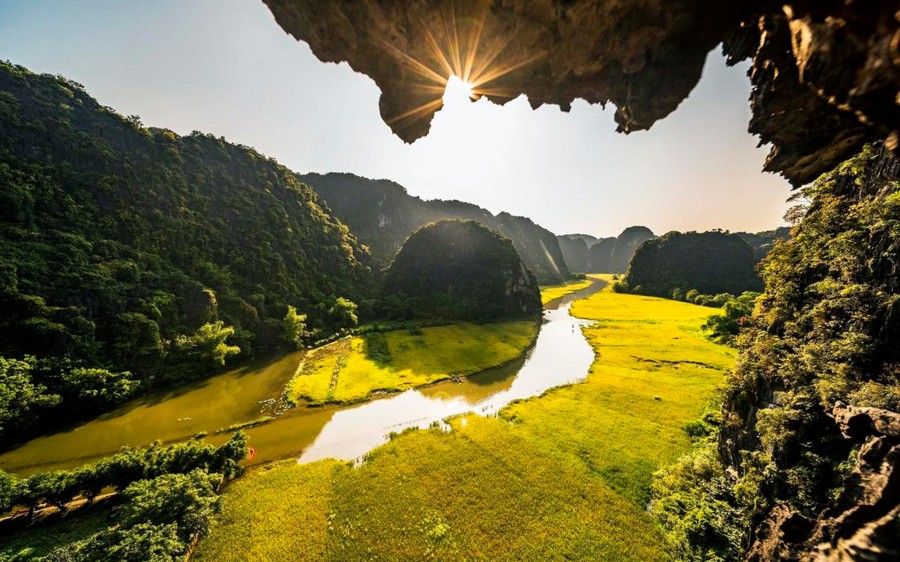
In the past decade, Ninh Binh has earned its place as one of Vietnam’s emerging travel stars. More like a “raw” experience without fenced nature or high-speed life, Ninh Binh offers visitors a peaceful holiday. Travelers can row through a misty cave, bike through golden fields, and visit temples at least a thousand years old – some of the most iconic things to do in Ninh Binh. If you’re looking for something less commercial, but similarly beautiful and authentic, Ninh Binh is worth your time.
What Is The Best Time To Visit Ninh Binh?
Ninh Binh, as a gem in Vietnam, remains stunning all year round. However, if the plan is to find the finest sight of open skies, pleasant weather conditions, and the best photographs possible, then timing will play a role here. The best time to visit Ninh Binh is during the spring and fall months, when the weather conditions are sunny and the environment is vibrant and untouched.
March to May (Spring)
The spring of Ninh Binh is clean and energetic. The air is clean, temperatures are well-balanced, cool and the rice fields start to turn green. Boat rides through Tam Coc are more enjoyable in this kind of weather, and the hike to the top of Mua Cave is less strenuous. You’ll even spot more local life on the outside – farmers working on the plots, street markets in full roar, and landscapes that feel limitless.
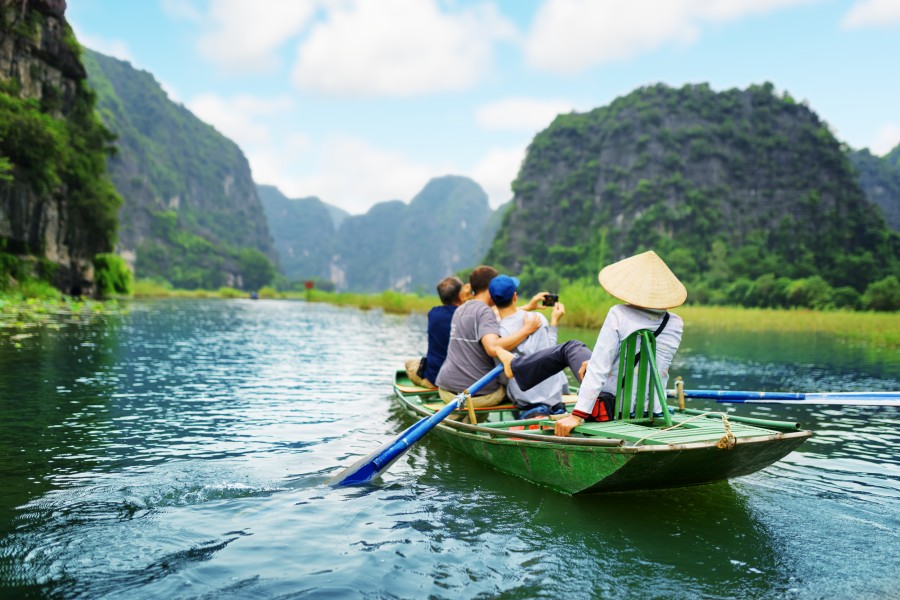
September to November (Autumn)
Autumn bathes Ninh Binh in warm golden tones. Photographers can capture the inclination in the shade of a warm yellow in the fields, especially while the photo shoot of sunrise or sunset, post summer harvest. The air cools, the clouds burst, and the heat becomes more bearable. This is also the most picturesque time of year, with fewer tourists, the best light, and a gentler pace in tune with the peaceful landscape.
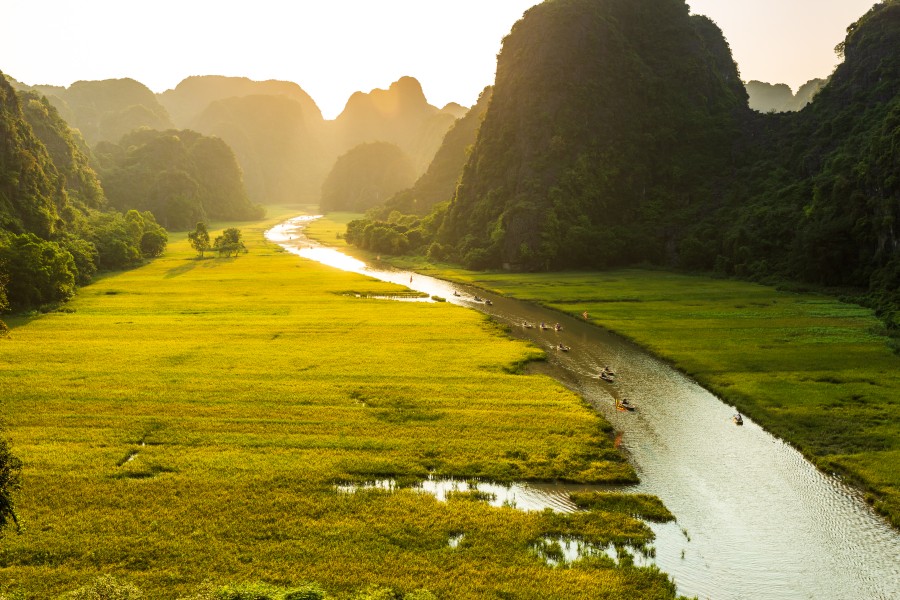
Ninh Binh Weather Overview By Season
Ninh Binh is home to four seasons, each with a different feeling and way to travel. The landscapes will always look beautiful, but the weather impacts your comfort and the chances of you doing things outside. That’s why many travelers check the Ninh Binh weather by month before they go.
| Season | Months | Temperature (°C) | Typical Weather Experience |
| Spring | March – May | 20 – 28 | The weather is mild and nice with more sunshine and less humidity. The landscape is lush, even though the rice paddies don’t grow, but the majority of the skies are notably clear, mostly throughout the day. |
| Summer | June – August | 28 – 36 | Days are hot and often humid, expect short bursts of rain in the afternoon as well as tropical and even showers. Early mornings are better spent outside and playing in the fields, as the peak of the mid-day heat can be intense. |
| Autumn | September – November | 23 – 30 | Temperatures are cooler and much more stable, and rainfall is also significantly lower. This time of year can look the most scenic, especially after the harvest of the previous rice harvest, when all the paddies have turned golden. |
| Winter | December – February | 12 – 20 | The air cools, particularly in the early morning and late evening. Fog often blankets the rivers and mountains, creating a quiet, misty atmosphere to travel slowly. |
Spring (March to May)
The first few months of spring have a soothing impact on Ninh Binh temperatures. Temperatures start rising, generally ranging between 20°C and 28°C. Skies are generally clear during March and April, and have more sunny weather and lower humidity, resulting in easy-to-breathe air. Rain is scarce, and mornings are cool enough for boat tours or long walks between the rice fields without getting soaked in the warm sun.

The landscape slowly turns from pale to green as rice shoots fill the fields. Around late April, the Truong Yen Festival takes place in Hoa Lu, re-creating the rituals of ancient dynasties with music, processions, and vibrant local participation. Spring in Ninh Binh feels like a fresh beginning, with enough color, calm, and culture to make every moment linger.
Summer (June to August)
Ninh Binh is dry and hot in summer. The daytime temperatures are raised to 35°C or even higher, as the sun rises quite early and remains high. In the summer, humidity builds after sunrise, and the intense afternoon downpours usually come as a familiar rhythm, especially in Ninh Binh in July. The mornings can be warm but bright with cool winds, making a couple of hours of sightseeing possible before the air becomes sluggish.
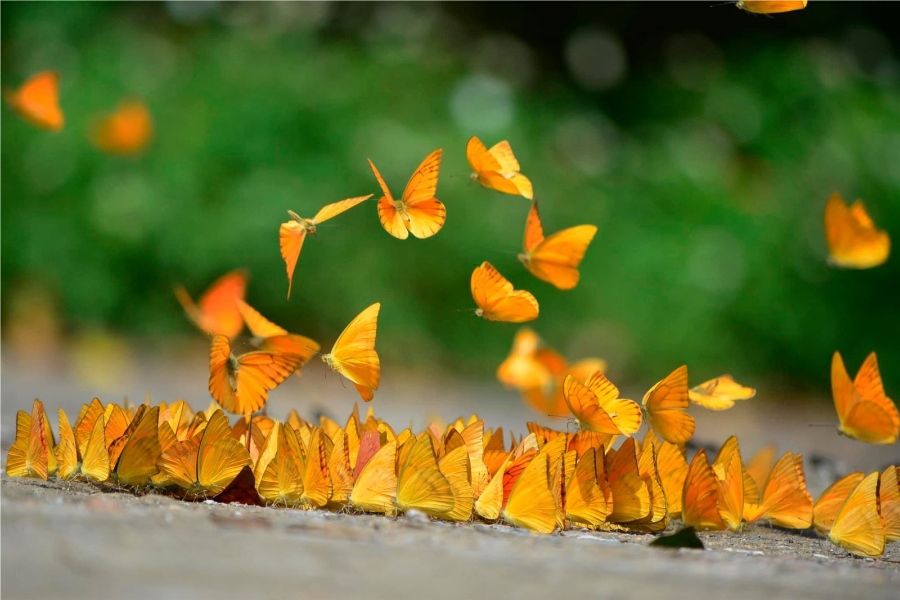
This is often considered the best time to visit Ninh Binh thanks to its wild, vibrant beauty. Late summer is the time of Vu Lan, the Vietnamese festival of filial piety, which celebrates deceased family members and the ages of family members. You can visit the pagodas and meet families gathering to remember relatives in quiet, multi-colored rituals.
Autumn (September to November)
Just like the heat dissipates, Ninh Binh relaxes into a kind and giving routine. The temperatures decrease to a range between 23°C and 30°C, and the air becomes dry; therefore, it is easy to spend more time outside. There are bluer skies, and rain becomes uncommon by late September. This is when the landscape starts to shine under softer light, particularly in the late afternoon.

After the rice harvest, the area becomes quieter with cooler air and calmer boat rides. With trails that are easier to explore, this is seen as the best time to visit Ninh Binh. Around the Mid-Autumn Festival, paper lanterns appear in villages, and local bakeries sell sweet mooncakes with salted yolks inside. For travelers who prefer open skies, warm colors, and stillness, autumn gives more than enough reasons to stay longer than planned.
Winter (December to February)
In winter in Ninh Binh, the cold is mild, but it does not fade away. Morning can drop to 12°C, and on most days the temperature remains below 20°C even in the afternoon. It barely rains, but the sunset comes early, and clouds regularly cover the rivers and the mountains with growing mist. It is a time when people do not have much time to sightsee and enjoy a fair weather atmosphere.
Tour groups become fewer, and boat rides through Trang An or Tam Coc feel quieter and more personal. As Tet approaches, signs of the new year begin to appear in local villages. Peach blossoms begin to appear, village markets grow busier, and red envelopes show up in shopfronts. Winter strips the scenery to its barest form, but in that stillness, Ninh Binh reveals a side that feels slower, more intimate, and just as rewarding.
Tips For Visiting Ninh Binh In Different Seasons
The weather in Ninh Binh can change quickly from month to month, so knowing a few seasonal tips can help you avoid unexpected problems and make the most of your trip.
- Spring mornings can feel chilly on the river, so pack a light jacket if you plan to take early boat rides.
- If you’re visiting during local festivals like Truong Yen (April) or Tet (late January to early February), book your accommodation and transport well in advance.
- Summer heat builds quickly after 10 a.m., so plan hikes or boat trips early in the morning.
- Sudden afternoon rain showers are common from June to August, so bring a compact umbrella or poncho wherever you go.
- Autumn is great for cycling and hiking, but the sun can still be strong, so wear sunblock and carry water.

- Around the Mid-Autumn Festival, villages can be busier than usual in the evenings, especially near temples and schools.
- In winter, fog can reduce visibility, especially in the early morning, so avoid tight schedules if you plan to visit viewpoints.
- Some small family-run boat services may close during Tet, so confirm in advance if you’re traveling during the holiday.
- Ninh Binh is more peaceful on weekdays. If you want to avoid local tourist crowds, try to skip weekends and public holidays.
FAQs About The Best Time To Visit Ninh Binh
Uncertain if summer storms will ruin your boat trip, or when the rice fields will turn gold? Here’s what travelers typically ask before booking Ninh Binh, and what you might want to know, too.
What if I come during the rainy season? Will it affect my plans?
The rainy season, from Jun-Aug, tends to have short but heavy downpours most afternoons. The mornings, on the other hand, are often dry and bright. Most outdoor activities (including boating and hiking) are still fine if you start early enough and are flexible with your plans.
When should I go to see the rice fields turning golden, like in the photos? When exactly?
The rice fields typically turn from green to deep yellow in mid-to-late September. This is when the harvest starts in Tam Coc, and the farmers cut the paddies. The light is soft in the early morning, which is also a good time to visit because it is usually calm at that hour.
What’s the most comfortable season for sightseeing and biking?
Spring, especially from March to May, offers the most pleasant conditions. The temperature stays between 20°C and 28°C, skies are mostly clear, and paths stay dry. It’s a great time to explore caves, cycle through rice fields, or take boat rides without the summer heat.

Does winter feel too cold or gloomy to enjoy Ninh Binh?
Winter brings cooler air and misty mornings, but it’s still a lovely time to visit if you prefer peace and fewer crowds. The scenery takes on a quiet, poetic tone, and boat rides feel more intimate. Just bring warm layers, especially for early mornings.
Are there any local events or festivals that are worth planning around?
Yes. The Truong Yen Festival in April takes place at the Hoa Lu Ancient Capital and includes traditional games, costumes, and ceremonies. Tet, Vietnam’s Lunar New Year, usually falls in late January or early February and brings a festive, spiritual vibe to temples and villages. Just keep in mind that accommodations can fill up quickly around these dates.
Final Thoughts: Are Ninh Binh Worth Visiting?
Ninh Binh doesn’t need to shout. Its beauty unfolds in quiet moments, a slow river winding through limestone peaks, a village path brushing past ripening rice, or a misty morning softening every sound. Your journey becomes more meaningful when it begins at the best time to visit Ninh Binh. And if you want it to feel seamless from the very first step, Seni World is here to help you begin with clarity and care.









